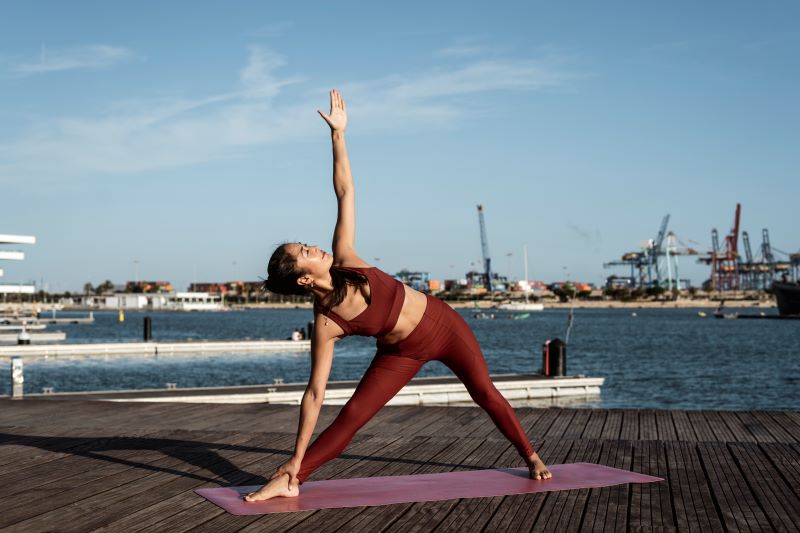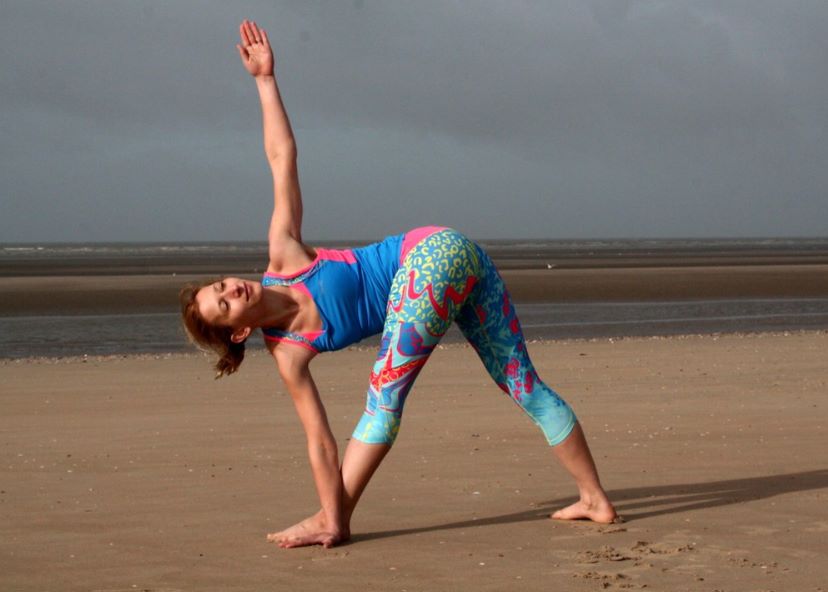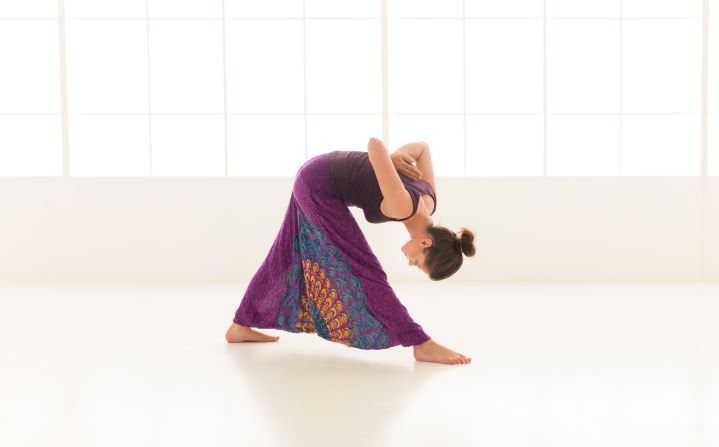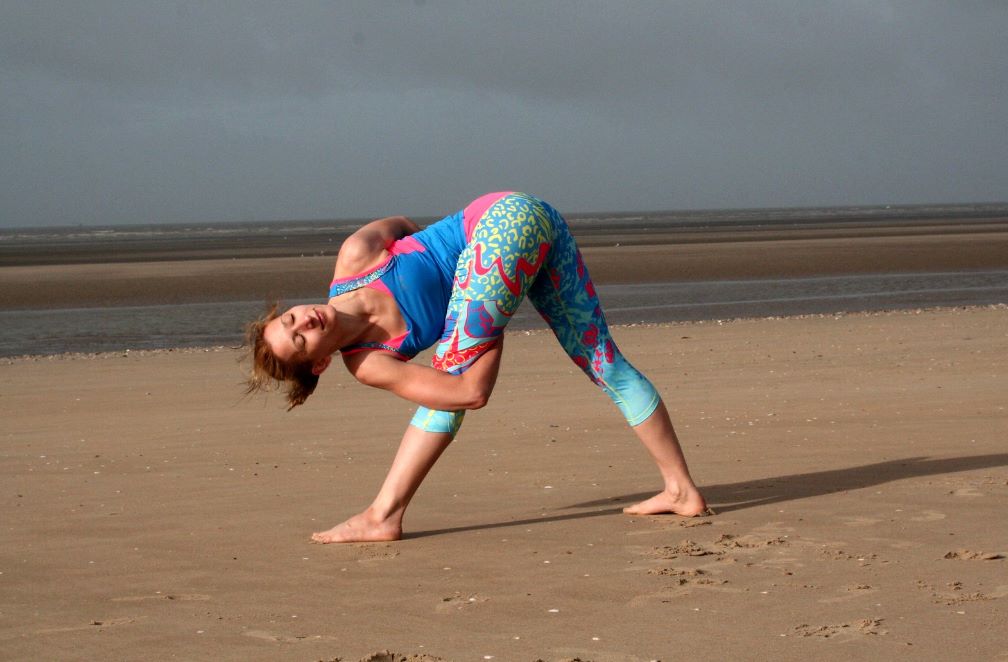How to Perform Triangle Pose (Trikonasana) & its Health Benefits
Trikonasana, or Triangle Pose, is a fundamental standing yoga posture emphasising alignment, flexibility, and strength. It is commonly practised in various styles of yoga, including Hatha, Vinyasa, and Iyengar. This pose involves a wide-legged stance, with one arm reaching toward the ground and another extending upwards, creating a triangular shape with the body.
It helps to improve balance, stretch the hamstrings and hips, and open the chest and shoulders. Trikonasana is accessible to practitioners of all levels and is a foundation for developing better posture and body awareness in yoga.

Table of Contents

What is a Triangle Pose (Trikonasana)?
There are many types of yoga poses, including "Trikonasana," or Triangle Pose, a modern-day yoga posture. The name Trikonasana has been derived from three Sanskrit words— "Tri," "Kona," and "Asana." Tri means three, Kona means angle, and Asana is a yoga position.
The three terms together become "three-angle pose." Let's learn more about the Triangle Pose in yoga, how to do it, and its benefits.
Yoga Level: Beginner
How to Perform Triangle Pose?

Step 1: Stand straight in the Tadasana position and spread your legs wide apart.
Step 2: With your arms wide apart, place your right foot at 90 degrees and your left foot at 45 degrees. Make sure that the weight distribution on both your legs is equal.
Step 3: Bend your body to the right side downwards and the left hand upwards. Breathing is important. Make sure that you inhale and exhale while going down.
Step 4: Maintain the exact posture with your eyes towards the ceiling.
Step 5: Rest your right hand on your toes or ankle, and your left hand should be raised towards the ceiling.
Step 6: Maintain this position for around 25 seconds and relax your body.
Step 7: To return to the original position, come up while inhaling and bring your arms downwards to the other side.
Variations of Trikonasana
There are several variations of Triangle Pose that can be used for better practice. If you find any poses difficult, it can be beneficial to try other less challenging and easy-to-implement variations. Add the following variations of Triangle Pose to your routine to elevate your mind and body.
1. Parivrtta Trikonasana

This is a revolved Triangle Pose. The right hand reaches the left foot, and the trunk is rotated with strength.
2. Supta Parivrtta Trikonasana
This reclining revolved Triangle Pose is similar to Marietta Trikonasana, with a minor difference in which the feet are pressed against the wall.
3. Supta Trikonasana
The body, legs, and arms are arranged exactly like standing trikonasana, but it is done by lying on the floor
4. Baddha Parivrtta Trikonasana

This is an advanced variation, which is the same as Marietta Trikonasana. However, it is performed with the hands joined.
5. Advanced Baddha Trikonasana

The legs and body are positioned like Trikonasana but with the left foot forward. The left arm reaches the front of the left thigh to catch the right arm, which goes behind the back. The right foot may be turned outwards more than usual for additional upward torso rotation.
Benefits of Doing Triangle Pose
Trikonasana, or Triangle Pose, is one of the first standing poses you can learn under yoga asanas. Trikonasana can benefit you both physically and mentally. The benefits of Triangle Pose have been listed down below:
- Stretches Ankle, Knee, and Hip Muscles: Practising Trikonasana stretches the muscles around your ankles, knees, and hips. This increased flexibility helps improve overall lower body mobility. It also enhances joint health and reduces the risk of injury.
- Boosts Metabolism and Aids Digestion: The pose stimulates the abdominal organs, boosting metabolism and aiding digestion. The twisting motion helps massage internal organs, promoting better digestive health. Regular practice can alleviate digestive issues and improve metabolic rate.
- Reduces Fat Around Thighs and Tummy: Trikonasana targets the thigh and abdominal areas, helping to reduce fat in these regions. The sustained muscle engagement burns calories and tones these areas. Consistent practice contributes to a leaner physique.
- Opens Chest and Back Muscles: The stretching involved in Trikonasana opens up the chest and back muscles, enhancing respiratory function and improving posture. It also alleviates tension in the upper body, promoting better breathing and relaxation.
- Calms the Mind and Energises the Body: Trikonasana has a balancing effect on the body and mind, promoting mental clarity and calmness. Physical exertion combined with mindful breathing energises the body, helping reduce stress and anxiety.
- Improves Kidney Function: The pose stimulates the kidneys, promoting better filtration and detoxification. Enhanced kidney function contributes to overall health and wellness. This stimulation aids in maintaining the body's fluid balance and removing toxins.
- Enhances Hamstring Flexibility and Groyne Strength: Trikonasana significantly improves hamstring flexibility and strengthens the groyne muscles. The extended stretch helps lengthen these muscles, reducing tightness. Stronger, more flexible hamstrings and groyne muscles support better movement and athletic performance.
Safety Precautions to Take While Performing Triangle Pose
Here are some safety precautions to take while performing the Triangle Pose:
Strengthening your legs and core is crucial for holding Trikonasana longer. To build this strength, practise the swaying palm tree position and standing spinal twist.
Good balance and flexibility enhance the alignment of the Triangle Pose. To improve these attributes, practice asanas such as Uttanasana (standing forward fold), Vrikshasana (tree pose), and Malasana (runner's stretch and side squats), making Trikonasana easier to perform.
If you have difficulty reaching your shin or ankle, place a yoga block on the floor inside your foot, close to your big toe. Rest your hand lightly on the block, avoiding putting too much pressure on it.
To avoid straining your neck, shift your gaze downward. Focus on your yoga mat or big toe instead of looking at your extended hand. This adjustment helps keep your neck relaxed and aligned with your spine, preventing unnecessary tension.
What Are the Easy Modifications of Triangle Pose?
You may find it difficult to ace the triangle pose at the beginning. Therefore, keep reading to learn the easy modifications:
- Take the Help of a Block: If you face difficulties keeping your bottom hand on your shin or ankle, place a block inside your foot and close your big toe. Rest your hand on this block without exerting much pressure on it. Try to keep your hand loose and energy moving upward.
- Look Down: You can shift your gaze to your yoga mat or your big toe to avoid stressing your neck.
- Rest Your Hand Higher on Your Leg: Instead of a yoga block, you can rest your hand higher on your leg, like on the shin or toward your knee. However, ensure to place your hand lightly on the leg with a strong core and legs for optimum support.
Triangle Pose in yoga brings balance to both the mind and the body and reduces nerve depression. Add variations along with the pose and practise them regularly for health benefits.
Who Should Avoid Practising Triangle Pose?
Trikonasana is a popular standing yoga pose that stretches and strengthens various body parts. However, specific individuals should exercise caution or avoid this pose entirely to prevent injury or discomfort. Here are some groups who should avoid practising the Triangle Pose:
- Individuals with Neck Injuries: Twisting the neck can exacerbate existing injuries.
- Those with Lower Back Problems: The forward bending can strain the lower back.
- People with Hip Injuries: The pose can put undue pressure on the hips.
- Individuals with High Blood Pressure: The pose involves bending, which may affect blood pressure levels.
- Pregnant Women: The pose may be uncomfortable or risky, especially in the later stages of pregnancy.
- People with Heart Conditions: The physical strain can harm those with heart issues.
- Individuals with Balance Issues: The pose requires good balance and stability.
- Those with Severe Osteoporosis: The pose can stress bones and joints.
- Individuals with Migraines: The head positioning can potentially trigger or worsen migraines.
- People with Recent Surgery: Any recent surgery involving the abdomen or back requires caution and possibly avoiding the pose.
Incorporating the Triangle Pose into your routine can significantly enhance your health and well-being. This classic yoga pose offers numerous benefits, including improved flexibility, strengthened muscles, better posture, and enhanced mental focus. By stretching and engaging various muscle groups, the Triangle Pose promotes physical balance and coordination while reducing stress and tension.







